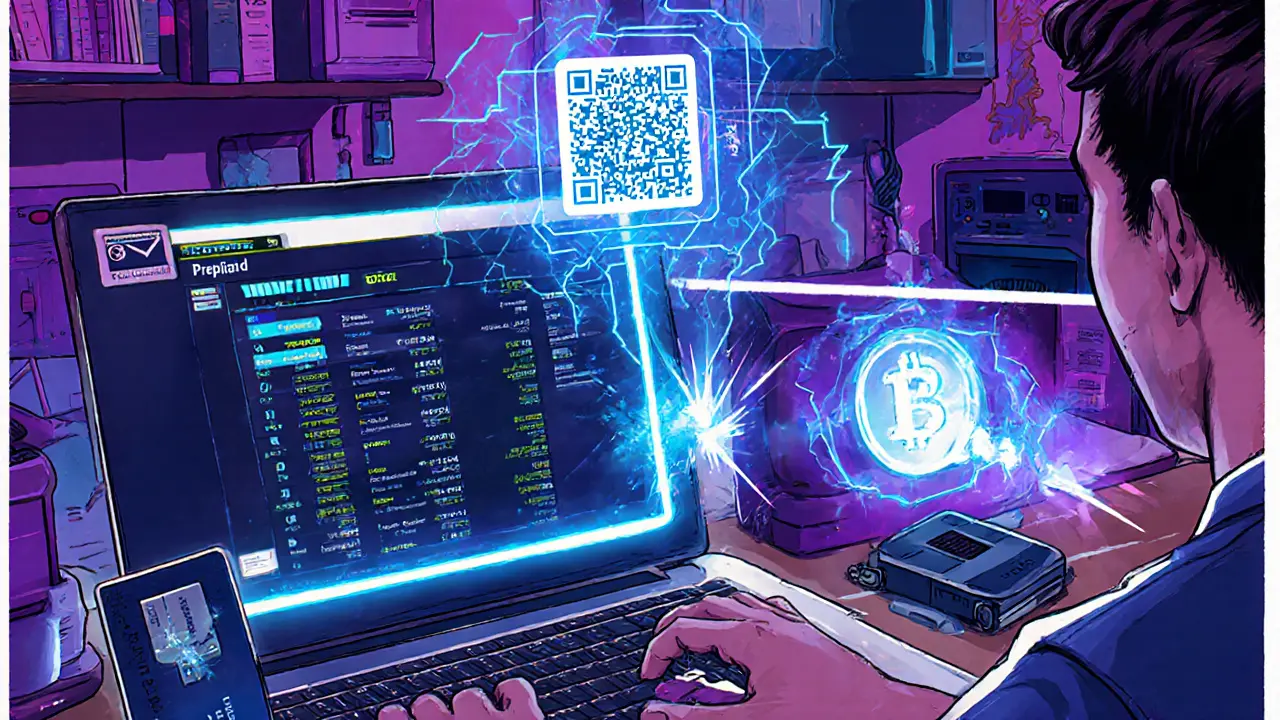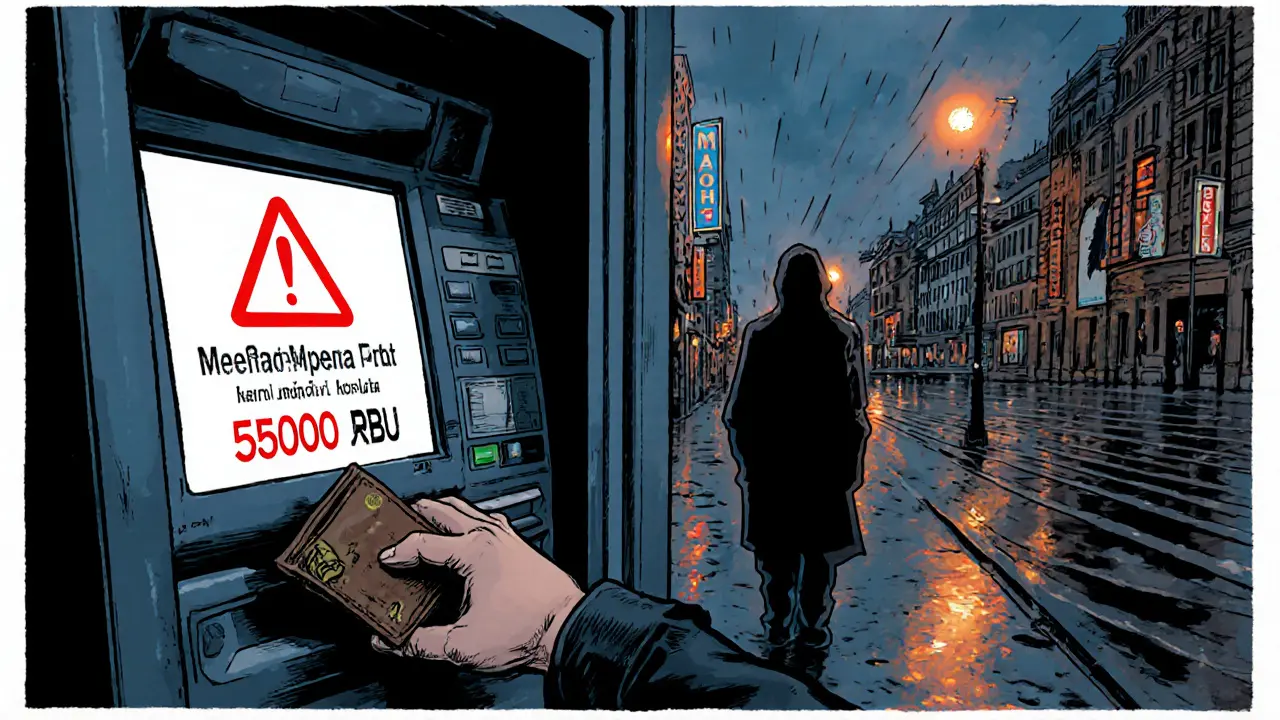Russia crypto ban: Bitcoin trading workarounds & alternatives
Russia Crypto Ban Impact Calculator
About This Tool
This calculator helps you understand how Russia's 2025 crypto banking ban affects your trading activities. Enter your monthly trading volume and preferred method to see estimated compliance requirements and alternative approaches.
Analysis Results
Enter your details and click "Analyze My Trading Impact" to see personalized recommendations.
Imagine trying to buy Bitcoin in Moscow, but every ATM you walk to suddenly stops letting you pull out more than 50,000 rubles. That's the reality for thousands of traders after September2025, when Russia’s new banking rules hit the crypto world hard. If you’re wondering how to keep the trades flowing, what legal shortcuts exist, and which long‑term options might actually survive the crackdown, you’re in the right place.
Quick Take
- The Central Bank of Russia (CBR) now caps cash withdrawals at 50,000RUB for flagged accounts.
- Cash‑heavy P2P desks and small exchange offices are hit hardest.
- Workarounds include foreign exchanges, stablecoin corridors, and crypto‑enabled banking pilots.
- Long‑term alternatives focus on licensed domestic exchanges or a state‑run crypto bank.
- Compliance, transaction history, and vigilant AML practices are non‑negotiable.
What the Ban Actually Says
Russia's crypto banking ban is a regulatory framework introduced by the Central Bank of Russia on 1September2025. It forces banks to freeze daily ATM cash withdrawals at 50,000rubles ($600) for any account that triggers a set of fraud‑watch flags, such as unusually large withdrawals, sudden spikes in mobile‑banking activity, or transfers above 200,000rubles. While the law targets fraud, its side‑effect is a chokehold on the cash‑centric Bitcoin trade that powers most Russian P2P platforms.
Who Is Directly Affected?
The ban doesn’t ban Bitcoin outright, but it reshapes who can actually move fiat into crypto:
- Small exchange desks that rely on walk‑in cash sales.
- P2P traders who split large deals across multiple days to dodge the limit.
- Crypto miners in the ten regions where mining was halted early 2025, who previously sold hash power for cash.
- Any qualified investor (portfolio>100MRUB, income>50MRUB) - they can still access regulated channels, but they now need tighter AML documentation.
Immediate Workarounds That Traders Are Using
When the official route is blocked, users turn to three pragmatic shortcuts:
- Foreign crypto exchanges - Platforms like Binance, Kraken, or Bybit accept deposits via Visa/MasterCard, which are less likely to trigger the CBR’s cash‑watch module. You’ll still need a foreign‑linked card or a bank account outside Russia.
- Stablecoin corridors - Convert rubles to a stablecoin (USDT, USDC) on a domestic P2P desk that operates on a digital‑only basis, then move the stablecoin to an offshore exchange. This avoids cash altogether.
- Crypto‑enabled banks (pilot projects) - A handful of banks in Belarus and a few Russian “crypto‑bank” pilots let users hold Bitcoin within a custodial account, turning the asset into a quasi‑fiat that can be transferred via SWIFT without pulling cash.

Step‑by‑Step: Using a Foreign Exchange Safely
Below is a practical checklist for anyone who wants to keep trading while staying on the right side of the law:
- Open an account on a reputable exchange that accepts Russian users (e.g., Binance).
- Link a prepaid Visa/MasterCard that’s issued outside the Russian banking system. Many Russian residents obtain such cards through e‑residency services in Estonia or the UAE.
- Enable two‑factor authentication (2FA) and set up anti‑phishing codes offered by the exchange.
- Deposit rubles via the card. The exchange will convert to the base currency (usually USD or EUR) before you buy Bitcoin.
- Trade only amounts that keep your daily card spend under 100,000RUB to avoid triggering card‑issuer fraud alerts.
- Withdraw Bitcoin to a hardware wallet or a personal software wallet to keep it off‑exchange.
Tip: Keep a spreadsheet of every card‑top‑up, its date, amount, and the exact exchange rate. The CBR can request this history if they flag your account.
Building a Digital‑First P2P Model
Many small desks are pivoting from cash to a fully online workflow. Here’s what the new playbook looks like:
- Use QR‑code payment links that tie each transaction to a unique identifier. This makes it easier to prove a “regular pattern” to the bank.
- Adopt virtual debit cards issued by fintechs like Revolut or Wise. These cards sit on the exchange balance, so no cash leaves the system.
- Implement escrow contracts using smart‑contract platforms (e.g., Ethereum) to protect both buyer and seller.
- Report daily volumes to your partner bank, showing a consistent flow under the 50,000RUB ceiling.
Those who manage to keep the digital trail clean report a 2‑3‑month adjustment period before the bank’s monitoring system stops flagging them as suspicious.
Long‑Term Alternatives: What Will Survive the Ban?
Looking beyond quick fixes, analysts see three viable paths for the Russian crypto ecosystem:
| Solution | Regulatory Status (2025) | Key Benefit | Major Risk |
|---|---|---|---|
| State‑backed Crypto Bank | Proposed, pending CBR approval | Bank‑grade security, direct fiat‑crypto conversion | Potential for heavy government control |
| Licensed Domestic Exchange Network | Pilot licences granted to 3 operators | Legal certainty, access for qualified investors | Still limited to high‑net‑worth users |
| Cross‑border Stablecoin Corridors | Unregulated but tolerated | Low transaction fees, bypasses cash limits | Exposure to stablecoin peg risk |
| Decentralized Finance (DeFi) Bridges | Technically illegal for retail use | Complete autonomy, no intermediaries | High regulatory crackdown risk |
For most traders, the state‑backed crypto bank looks promising because it blends the familiarity of a traditional bank with built‑in crypto wallets. However, until the legislature signs off, the most dependable route remains a licensed domestic exchange, albeit restricted to investors who meet the 100MRUB portfolio threshold.
Risks, Compliance Tips, and Common Pitfalls
Even the slickest workaround can backfire if you ignore a few hard‑won lessons:
- Transaction pattern spikes - sudden jumps in volume will instantly flag your account. Phase in larger trades gradually.
- Use of QR codes and virtual cards - the CBR’s monitoring engine now scans these for anomalous signatures. Stick to providers that share API logs with your partner bank.
- Documentation fatigue - keep receipts, chat logs, and exchange statements for at least 12months. Audits have become routine.
- Geopolitical sanctions - any cross‑border transfer involving sanctioned entities can freeze your assets overnight.
- Tax reporting - Russia’s 2025 tax code now treats crypto gains as taxable income for qualified investors. Register all sales through a licensed broker to stay compliant.
By treating compliance as a feature rather than an afterthought, you’ll avoid the costly “account frozen” scenario that befell dozens of P2P desks in August2025.
Frequently Asked Questions
Can I still buy Bitcoin with cash in Russia?
Direct cash purchases are now limited to 50,000RUB per flagged account. Most traders split larger trades across days or move to digital‑only methods such as foreign exchanges or stablecoins.
Is using a foreign exchange legal for Russian residents?
There is no explicit ban on acquiring crypto from overseas platforms. However, you must obey AML reporting rules and keep thorough transaction records to avoid CBR investigations.
What’s the difference between a crypto‑enabled bank and a licensed exchange?
A crypto‑enabled bank offers custodial wallets linked to a traditional bank account, allowing fiat‑crypto swaps without leaving the banking ecosystem. A licensed exchange is a separate entity that matches buyers and sellers but typically requires higher investment thresholds for Russian users.
How can I protect myself from the CBR’s fraud‑watch flags?
Maintain a steady transaction pattern, avoid sudden large withdrawals, use the same card and device for crypto purchases, and submit regular transaction summaries to your bank.
Will the crypto ban affect miners’ earnings?
Yes. Miners in the ten restricted regions now rely on digital sales or foreign platforms to cash out. Those who keep a stablecoin pipeline can still convert earnings without hitting the cash limit.






17 Comments
emmanuel omari
December 6 2024Russia’s ban is a textbook case of the state trying to choke off the lifeblood of its own tech‑savvy citizens, and it will only push traders into the shadows where they can operate more efficiently.
Andy Cox
December 14 2024the limits on cash withdrawals basically force anyone who wants to move more than a few thousand rubles into a foreign platform and that’s what we’re seeing across the board
Courtney Winq-Microblading
December 21 2024The crypto ban forces us to confront the paradox of a state that claims to protect its financial system while simultaneously strangling the very innovation that could secure its future. When you strip away cash, you are not just limiting petty traders, you are dismantling the informal networks that have kept the economy afloat during sanctions. In a country where bank accounts are often politicized, the underground P2P scene becomes a form of civil resilience. Legal scholars argue that the regulation walks a thin line between AML compliance and outright repression. From a technical perspective, the shift toward stablecoin corridors is a natural evolution of the market’s need for liquidity. Stablecoins act as a quasi‑fiat, bypassing the cash ceiling while preserving price stability. However, the peg risk cannot be ignored, especially when the underlying reserves are opaque. Foreign exchanges provide a bridge, but they also expose users to geopolitical compliance checks that can freeze assets on a whim. Crypto‑enabled banks, though still experimental, promise custodial solutions that integrate with the traditional banking stack. If the state can certify these pilots, they may become the sanctioned pathway for high‑net‑worth investors. Yet the average trader will likely remain stuck in a patchwork of QR‑code links and virtual cards. The most sustainable answer may be a regulated domestic exchange that meets AML standards without the 50,000 RUB cap. Such an exchange would need to enforce consistent transaction patterns, a requirement that many small desks find onerous. In the meantime, diligent record‑keeping and gradual volume scaling are the best defense against CBR flags. Ultimately, the ban is less about stopping crypto and more about forcing the market into a transparent, traceable digital ecosystem.
Jayne McCann
December 29 2024It’s just another way to make crypto harder.
Richard Herman
January 6 2025While the cash cap hurts small desks, the push toward digital wallets could actually raise the overall security standards for Russian traders if they adopt proper KYC practices.
Stefano Benny
January 13 2025From a market‑structure angle the Russian fiat‑crypto clamp‑down reshapes liquidity pipelines 🚀. First, the immediate effect is a contraction of on‑ramps that rely on cash‑intensive P2P desks 📉. Second, traders migrate to Visa‑linked foreign exchanges, which introduces higher transaction fees and KYC friction 💳. Third, stablecoin corridors emerge as the de‑facto bridge, but they carry smart‑contract risk and peg volatility 🪙. Fourth, crypto‑enabled banks pilot a custodial model that could legitimize on‑ramps if regulators grant a sandbox licence 🏦. Fifth, the CBR’s monitoring algorithm now flags volume spikes, so a gradual scaling strategy is essential 📊. Sixth, employing virtual debit cards from fintechs like Wise sidesteps cash limits while maintaining a digital footprint 💡. Seventh, consistent transaction patterns can be demonstrated by automating daily micro‑deposits under the 50k RUB ceiling 🔄. Eighth, robust AML documentation-including exchange receipts, timestamps, and exchange‑rate logs-reduces audit risk 📁. Ninth, tax compliance is non‑negotiable; crypto gains for qualified investors are now taxable income under the 2025 code 🧾. Tenth, cross‑border stablecoin pipelines must be monitored for sanction watch‑lists to avoid asset freezes 🚫. Eleventh, decentralized finance bridges remain technically illegal for retail users, but they provide a sandbox for advanced traders looking to hedge exposure 🛡️. Twelfth, the state‑backed crypto bank, if approved, could unify fiat‑crypto conversion with SWIFT settlements, offering the most seamless experience 🏛️. Thirteenth, until that materializes, the safest long‑term route is a licensed domestic exchange that enforces AML while offering tiered access based on net‑worth thresholds 📈. Fourteenth, community education on compliance best‑practices will be a critical differentiator for operators seeking to stay afloat 📚. Fifteenth, the market will self‑organize around the most resilient infrastructure, and those who adapt quickly will capture the emerging liquidity pools 🚢.
John Kinh
January 21 2025Looks like a messy workaround to me.
Nathan Blades
January 29 2025Here’s a quick checklist to keep your Bitcoin flow alive despite the cash cap:
1. Open an account on a reputable foreign exchange that still accepts Russian users.
2. Get a prepaid Visa or MasterCard issued outside Russia – e‑residency services in Estonia or the UAE work well.
3. Enable 2FA and store recovery codes offline.
4. Fund the card with RUB, keeping daily spend under 100 000 RUB to stay under fraud alerts.
5. Convert to USD/EUR on the exchange before buying BTC.
6. Pull the BTC to a hardware wallet the moment you’re done trading.
7. Keep a spreadsheet of every top‑up, date, amount, and exchange rate – the CBR can ask for it.
Follow these steps and you’ll stay within the law while keeping your trades moving.
MARLIN RIVERA
February 6 2025The so‑called “workarounds” are just a band‑aid on a bleeding wound; they shift risk to foreign jurisdictions, expose users to unstable stablecoins, and give regulators a fresh set of data points to clamp down on. By funneling money through offshore cards you’re inviting AML scrutiny from multiple agencies, and any slip‑up could lock your assets for good. In short, there’s no safe haven – the ban simply pushes the ecosystem into a gray zone where compliance is a guessing game.
Debby Haime
February 13 2025Don’t let the new limits freeze your ambition – the crypto community always finds a way, and the tools we’ve listed are proven to work when you stay disciplined and keep good records.
katie littlewood
February 21 2025I totally get the frustration of watching the ATM screens refuse your withdrawal, it feels like the system is punching you in the gut every time you try to move money. What’s amazing, though, is how quickly the community has rallied around digital alternatives, turning a regulatory roadblock into an innovation sprint. By swapping cash for QR‑code payments, we’re not just sidestepping the cap, we’re building a more transparent ledger of every trade. Virtual cards from Wise or Revolut act like a Swiss army knife, giving us the flexibility to hop between fiat and crypto without ever touching ATMs. When you pair that with a trusted hardware wallet, you’re essentially creating a personal bank that the central bank can’t raid. Consistent transaction patterns are the unsung hero here – the more regular your activity, the less likely you’ll trigger the CBR’s alarm bells. I’ve seen desks that post daily micro‑deposits under the 50k RUB ceiling and stay completely under the radar for months. Documentation is another pillar; a spreadsheet with timestamps, exchange rates, and receipt PDFs can be the difference between a smooth audit and a frozen account. It’s also worth noting that stablecoins, while not perfect, provide a “peg safety net” that lets you hold value without converting back to volatile rubles. Keep an eye on the peg health, and you’ll avoid nasty surprises. Lastly, community forums and local meet‑ups are gold mines for sharing the latest workarounds and compliance hacks. Stay connected, stay diligent, and the ban will just be another bump on the road to a more resilient crypto ecosystem.
Jenae Lawler
March 1 2025In light of the recent legislative measures, it is incumbent upon market participants to re‑evaluate their operational frameworks with a view toward regulatory conformity and systemic resilience.
Chad Fraser
March 8 2025Sounds solid – just keep it simple and stay on top of the paperwork.
Parker Dixon
March 16 2025The Russian crypto ban certainly narrows the avenues for cash‑based trading, yet it simultaneously accelerates the migration toward compliant digital channels. Foreign exchanges, while offering broader liquidity, impose stricter KYC and can be subject to sanctions, which adds a layer of geopolitical risk. Stablecoin corridors sidestep cash caps but introduce peg volatility, necessitating vigilant monitoring of reserve backing. Crypto‑enabled bank pilots could bridge the fiat‑crypto divide, provided they obtain full regulatory sanction, which remains uncertain. For most traders, the pragmatic approach is a hybrid strategy: maintain a minimal cash on‑hand for emergencies, utilize a reputable foreign exchange for bulk conversions, and keep a portion of assets in stablecoins for short‑term flexibility. Consistent record‑keeping and gradual volume scaling remain the most effective defenses against AML triggers.
Bobby Ferew
March 24 2025Sure, just keep juggling cards and spreadsheets while hoping the next decree doesn’t pull the rug out from under you.
celester Johnson
April 1 2025The efficacy of the workarounds hinges on the interplay between regulatory enforcement intensity and the adaptability of the crypto infrastructure; any shift in one variable will reverberate through the entire ecosystem.
Prince Chaudhary
April 8 2025To stay ahead, diversify your entry points, automate compliance reporting where possible, and keep monitoring legislative updates so you can adjust your strategy before restrictions bite.